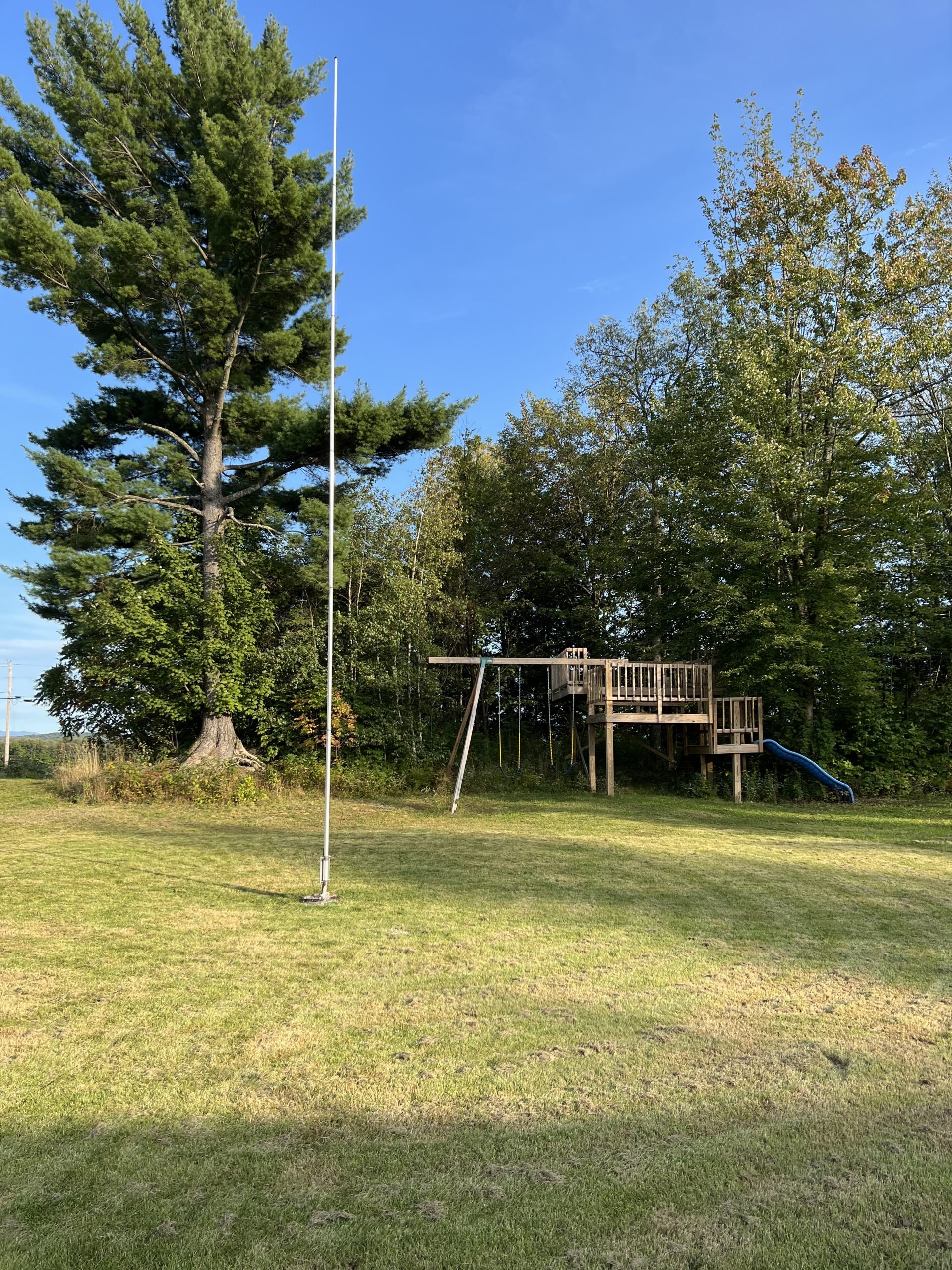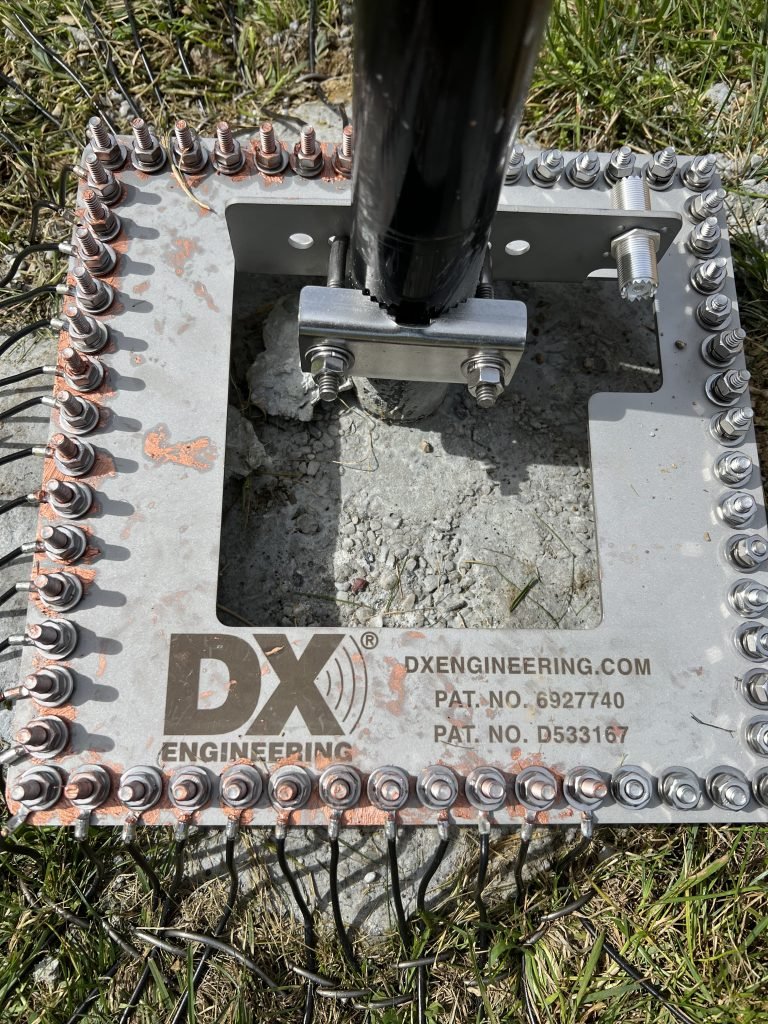Installing the Comtek 40-Meter Vertical Antenna
This long article will speak to installing the Comtek 40-meter vertical antenna. One of my objectives in moving to Vermont was to have enough land (2.3 acres) to do something a little more serious with low band antennas. In the past, I’ve had some sort of compromised antenna on both 40 and 80-meters - quarter wave off a tower has been the best one.
And on 40-meters, the best antenna I had in the past was a home-brew 40-meter vertical with a bunch of radial wires connected to a chain-link fence. Not very original, but it really worked. It was still a compromise as the back yard was small, the radials were not full length, and it radiated on one side into a hill going up to the next door neighbors lot.
Still, that antenna left an impression on me (this was from the 1980’s!). In addition, at the contesting stations I’ve been fortunate enough to participate in, I’ve seen the difference full-sized, well filled radial patterns can do. And, of course, even better if you can phase them.
Well, I’m not into phasing verticals. Outside of not having enough room, I’m a bit into trying to simplify what I’m doing and building phased verticals is not simple to me.
After a lot of research into 40-meter verticals, both on the internet and via YouTube, I decided on installing a Comtek 40-Meter Vertical - COM-40VA from DX Engineering. It looks to be well-built (it is after installing it) and reasonably priced.
Purchasing the Comtek 40-Meter Vertical
I’m starting my shack from nothing, outside of an Icom 7300 and power supply. So I needed a bunch of stuff for the install. One of the key decisions I made was that I was going to install all 60-radials available on the DX Engineering Radial Plate. There are a couple reasons for this:
Since the radials are the other half of the vertical part of the antenna, more radials makes the signal more efficient. It tends to lower your SWR given the height of the antenna against the number of radials
Radials appear to significantly drop the band noise. In practice here, I live far away from anything that creates noise (outside of electric lines coming in from the road to the house), so I don’t have much noise in the first place. But the noise level while operating so far hasn’t budged the S-meter.
The net of it to me is that I can hear better with more radials and I am getting more of my less than 100-watts out into the ether.
The purchase, then, consisted of:
The Comtek antenna
The DX Engineering Radial Plate
100-feet of coax
A grounding rod and lightening arrestors
The connecting cable between the radial plate (ground) and antenna.
60 runs of radial wire
A barrel connector on the radial plate for the incoming coax connecting to the antenna (see pictures)
300 staples to secure the radial wire into the ground (five staples per 32-foot radial)
Installing the Comtek 40-Meter Vertical - the hole
Anyone who has installed a vertical will tell you the hardest part is digging the hole. Here, I needed to dig only a two-foot deep hole and put in a 4-foot mast to hold the radial plate and vertical. I have fairly rocky soil where I live, and the hole took most of one day to dig (in, of course, really hot and humid weather).
The two-foot hole for the Comtek 40-meter vertical
Then one needs to dump in a couple inches of gravel for drainage at the bottom of the hole, then put in enough cement to fill the hole to the top - and ensuring the pipe that is in there is perfectly level so the antenna isn’t off 34-feet up in the air because of being a little off at the base.
Close enough!
Installing the Comtek 40-Meter Vertical - the Radials
If digging the hole is the hardest thing to do, the most time consuming is laying out the radials. Especially when there are 60 of them. The first thing I did was mow the grass down to 2-inches for 35-ish feet around the antenna base. It’s easier to lay the radials and keep them low to the ground by doing so. Then, I used this process for the radials:
Inside the house, I pulled the radial plate and then took all of the nuts and bolts and put them on the radial plate as shown in the directions. Easier to do it in the house than on the lawn as it’s too easy to lose stuff.
Install the radial plate onto the mast. Following the directions, this means up a couple of inches from the concrete so you can get the bolts in and out underneath the plate.
Then I would remove 3-5 bolts and associated hardware and put the hardware on the plate in an accessible position.
Then put on the copper SO-3 on each of the holes and the radial.
Then construct the bolts back into the holes including the radial in the mix (I forgot a couple and had to take it apart again!)
Tighten down the bolts
Place a staple at the base just beyond the cement to force the radial down to ground level.
When done with your 3-5 bolts, extend out the radials. Then put in staples about every eight feet to hold the radial down close to the ground.
Start on your next set of 3-5 radials.
I found that it took about two hours per ten radials. So about 12-hours overall.
About half way done - note the staples by the concrete
Some notes on laying radials:
I HIGHLY recommend getting the pre-made radial wires. This is more expensive because someone else is doing the measuring, cutting, and soldering. But this will save you SO MUCH TIME and hassle. If it takes 12-hours to lay down 60-radials, imaging how much more time it will take to measure 60-radials and solder on the ends. And then put the radials on the plate…
I HIGHLY recommend you buy the type of radial wire sold by DX Engineering (and I assume others). These radials will not twist or kink on you - you can simply roll them out and they will lay down straight. Buying wire for radials at big box stores are not designed for this use case.
The radials are spaced at the ends 40.75 inches apart. I stole this from an 80-meter vertical installation on YouTube where someone smarter than me figured the radials were 6-feet, 9.5 inches apart for 80-meters. Well, 40 meters divide by two and you get your 40.75 inches apart. And it worked pretty well - the screwdriver in this picture is my first radial location and the measuring tape show about a difference of 4-5 inches across 60-radials. I’ll take that as symmetrical enough..
40.75 inches between radial wires at the end. Only off a few inches after 60-radials.
The radials will cost way more than this vertical antenna.
Ready to put the radial plate on the mast
Installing the Comtek 4-Meter Vertical - the Antenna
After all that, the antenna didn’t take as much time. I set up two five gallon pails in the garage so I could get a little height on the sections to work on them.
I didn’t take pictures of the assembly, but basically you install the base section that fits over the mast, then fit each of the sections into each other. You end up with an antenna that is 412-inches, or 34.33 feet, tall.
Then you take the antenna out and place it over the mast (need a helper here…). From there, you install the connecting coax from the radial plate to the vertical antenna. Then connect the coax from the shack to the radial plate (you see how good it is to get a radial plate? More than just radials…).
Got tired of doing radials, so installed the antenna. The connector cable is extra as is the barrel connector for the coax.
And this is the final product up in the air:
The tree in the background is twice as high as the 34’ antenna
Installing the Comtek 40-Meter Vertical - Performance
The antenna is advertised to have complete 40-meter band coverage with an SWR of less than 1.5 to 1. As per the instructions, the low SWR point should be around 7120.
In my case, because of all the radials I believe, my 1.0 to 1 SWR is right at 7000. And the SWR at 7300 is 1.5 to 1. After the contest this weekend, I’ll take the antenna down and adjust it a couple of inches and retest. I’m not going to go nuts trying to get it perfect as it’s really good where it is now.
On the band, I hear noise, but none of it has been registering on the S-meter. I can hear very weak signals just fine. I also attribute this to the number of full-size radials I have on the ground.
I’ve worked mostly FT8 at about 25-watts for the last several nights. I’ve worked well into Europe, South America, and the States. I haven’t worked anything in Asia or Pacific, but I have not been on the right times. I don’t work everything I call, but I’ve been very successful working stations.
This weekend is the CQWW RTTY contest where everything is essentially a multiplier - countries, states, provinces. As such I can work the vertical according to propagation, get lots of multipliers and see how the antenna plays both Stateside and with DX. And RTTY will allow me to run about 50-watts, so it will be interesting to see how that works out. I’ll be working 40-meter single band low-power. I can’t wait to see how the antenna performs.
I’ll report back on the results.
Oh, and next up? A full size 80-meter vertical with 60-radials as well.







